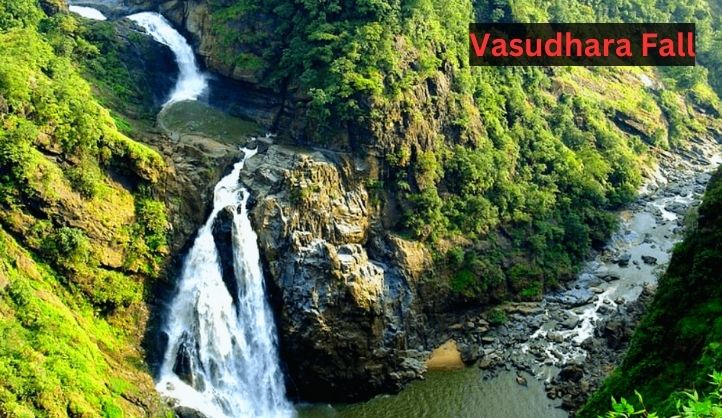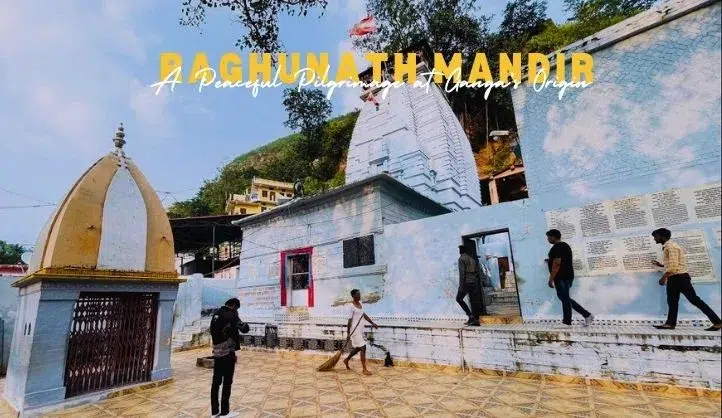Nestled in the lap of the Garhwal Himalayas in India, Vasudhara Falls stands as a testament to nature’s awe-inspiring beauty and power. Cascading from a height of around 400 feet, this majestic waterfall captivates visitors with its sheer grandeur and tranquil surroundings. In this article, we embark on a journey to explore the mystical allure of Vasudhara Falls, delving into its geological significance, cultural importance, and the immersive experience it offers to adventurers and nature enthusiasts alike.
Geological Formation
Vasudhara Falls owes its existence to the intricate geological processes that have shaped the rugged landscape of the Garhwal region over millions of years. Situated in the Chamoli district of Uttarakhand, India, the waterfall is formed by the waters of the Alaknanda River, a prominent tributary of the Ganges. As the river meanders through the Himalayan terrain, it encounters cliffs and rocky outcrops, creating the perfect conditions for the formation of cascading waterfalls like Vasudhara.
The geological composition of the region, characterized by sedimentary rocks and glacial deposits, plays a crucial role in determining the height and flow of the waterfall. Over time, the relentless force of water has carved a deep gorge, sculpting the landscape and giving rise to the breathtaking spectacle that is Vasudhara Falls.
How to reach Vasudhara Falls
By Air
The nearest airport to Vasudhara Falls is the Jolly Grant Airport in Dehradun, Uttarakhand. From Dehradun, you can hire a taxi or take a bus to reach Joshimath, which serves as the base for trekking to Vasudhara Falls. The distance between Dehradun and Joshimath is approximately 270 kilometers, and the journey takes around 10-12 hours by road.
By Train
The nearest railway station to Vasudhara Falls is Rishikesh Railway Station, which is well-connected to major cities like Delhi, Mumbai, and Kolkata. From Rishikesh, you can take a taxi or bus to reach Joshimath, covering a distance of about 250 kilometers. The train journey from major cities to Rishikesh takes varying durations, depending on the originating location.
By Road
Joshimath serves as the starting point for the trek to Vasudhara Falls. It is well-connected to cities like Dehradun, Rishikesh, and Haridwar by road. State-run buses, as well as private taxis and shared jeeps, ply regularly between these cities and Joshimath. The road journey offers stunning views of the Himalayan landscape, including snow-capped peaks, lush valleys, and quaint mountain villages.
Trekking to Vasudhara Falls
From Joshimath, trekkers embark on a scenic trek to reach Vasudhara Falls. The trekking trail passes through picturesque meadows, dense forests, and rocky terrain, offering breathtaking views of the surrounding Himalayan peaks. The trek covers a distance of approximately 9 kilometers (one way) and takes about 4-6 hours to complete, depending on the pace and weather conditions.
Map of Vasudhara Fall
Cultural Significance
Beyond its geological splendor, Vasudhara Falls holds profound cultural significance in Hindu mythology and folklore. According to local beliefs, the waterfall is associated with the legend of the Pandavas, the central character of the ancient Indian epic, Mahabharata. It is said that during their exile, the Pandava brothers traversed the rugged terrain of the Himalayas, seeking solace and spiritual enlightenment.
Legend has it that Draupadi, the wife of the Pandavas, was unable to complete the arduous journey to heaven due to her earthly attachments. In a moment of divine intervention, Lord Indra, the king of gods, created Vasudhara Falls to provide Draupadi with a celestial bath, cleansing her of worldly desires and facilitating her ascent to heaven. This mythological narrative has endowed Vasudhara Falls with a sense of sacredness and reverence, drawing pilgrims and devotees from far and wide to pay homage to its mystical aura.
Ecological Diversity
Beyond its cultural and geological significance, Vasudhara Falls is a thriving ecosystem teeming with biodiversity. The mist-shrouded cliffs surrounding the waterfall provide a conducive habitat for a myriad of plant and animal species adapted to the high-altitude environment of the Himalayas. Alpine flora such as rhododendrons, junipers, and birches adorn the rocky slopes, lending a vibrant splash of color to the verdant landscape.
The cascading waters of Vasundhara nourish the surrounding vegetation, sustaining a delicate ecological balance that supports diverse wildlife, including Himalayan birds like the Himalayan Monal and the Cheer Pheasant. The region surrounding the waterfall serves as a sanctuary for elusive mountain species such as the Himalayan Tahr and the Snow Leopard, adding to its allure as a haven for nature lovers and wildlife enthusiasts.
Adventures and Exploration
For adventurers and thrill-seekers, Vasudhara Falls offers a playground of exploration and adrenaline-pumping experiences. Trekking enthusiasts flock to the region to embark on the exhilarating journey to witness the cascading beauty of the waterfall up close. The trek to Vasudhara Falls begins from Mana village, the last inhabited village on the India-China border, and winds its way through lush meadows, dense forests, and rocky terrain, offering breathtaking vistas of the surrounding Himalayan peaks.
The trek presents a formidable challenge, testing the endurance and determination of trekkers as they navigate steep inclines and rugged pathways. However, the reward awaiting at the end of the journey makes every step worthwhile. As trekkers approach Vasudhara Falls, the thundering roar of cascading water grows louder, heightening the sense of anticipation and wonder. Finally, as the majestic waterfall comes into view, framed by the towering cliffs and verdant foliage, it leaves visitors spellbound, evoking a sense of humility and reverence in the face of nature’s magnificence.
Preservation and Sustainable Tourism
As the allure of Vasudhara Falls attracts an increasing number of visitors, ensuring the preservation of its pristine beauty and ecological integrity becomes paramount. Sustainable tourism practices, including responsible trekking, waste management, and conservation efforts, are essential to safeguarding the fragile ecosystem surrounding the waterfall.
Local communities play a vital role in promoting sustainable tourism initiatives and preserving the cultural heritage associated with Vasudhara Falls. By engaging in ecotourism activities, such as guided treks, cultural exchanges, and homestay experiences, these communities contribute to the economic development of the region while fostering a sense of environmental stewardship among visitors.
Furthermore, governmental and non-governmental organizations must collaborate to implement conservation strategies aimed at protecting the biodiversity hotspot encompassing Vasudhara Falls and its surrounding ecosystems. By establishing protected areas, enforcing wildlife conservation laws, and promoting community-based ecotourism initiatives, stakeholders can ensure that future generations continue to marvel at the splendor of this natural wonder.
Nearby places to Explore
Mana Village
Located just a few kilometers from Vasudhara Falls, Mana Village is renowned as the last inhabited village on the India-China border. Steeped in mythology and folklore, this picturesque village is dotted with traditional stone houses and offers stunning views of the surrounding mountains. Visitors can explore local handicrafts, interact with the friendly residents, and immerse themselves in the rustic charm of village life.
Badrinath Temple
Situated approximately 3 kilometers from Mana Village, Badrinath Temple is one of the holiest Hindu shrines dedicated to Lord Vishnu. Nestled amidst the majestic peaks of the Garhwal Himalayas, the temple is renowned for its intricate architecture, vibrant festivals, and spiritual significance. Pilgrims from across the country undertake arduous journeys to seek blessings at this sacred site, which forms part of the Char Dham pilgrimage circuit.
Valley of Flowers National Park
A UNESCO World Heritage Site, the Valley of Flowers National Park is a botanical paradise renowned for its stunning alpine meadows, vibrant floral diversity, and panoramic vistas. Located around 20 kilometers from Vasudhara Falls, the park is home to rare and endangered species of flora and fauna, including the elusive Blue Poppy and Himalayan Musk Deer. Visitors can embark on guided treks through the valley, soaking in the breathtaking beauty of this natural wonderland.
Hemkund Sahib
Perched at an altitude of 4,329 meters above sea level, Hemkund Sahib is a revered Sikh pilgrimage site nestled amidst the snow-capped peaks of the Himalayas. The gurdwara (Sikh temple) at Hemkund Sahib is dedicated to Guru Gobind Singh, the tenth Sikh guru, and is surrounded by crystal-clear glacial lakes and lush green meadows. Pilgrims undertake a challenging trek to reach Hemkund Sahib, seeking spiritual enlightenment and offering prayers amidst the serene mountain landscape.
Auli
Renowned as a skiing destination and a paradise for adventure enthusiasts, Auli is situated approximately 50 kilometers from Vasudhara Falls. Surrounded by oak and coniferous forests, Auli offers panoramic views of towering peaks like Nanda Devi and Trishul. Visitors can indulge in a variety of adventure activities, including skiing, trekking, and cable car rides while immersing themselves in the breathtaking natural beauty of the Himalayan landscape.
Nanda Devi National Park
Encompassing the Nanda Devi Biosphere Reserve, this national park is a UNESCO World Heritage Site renowned for its diverse flora and fauna, pristine wilderness, and dramatic landscapes. Located in close proximity to Vasudhara Falls, the park offers opportunities for wildlife spotting, birdwatching, and trekking amidst the towering Himalayan peaks.
Satopanth Lake
Tucked away in the remote reaches of the Garhwal Himalayas, Satopanth Lake is a sacred glacial lake revered by Hindu pilgrims. Surrounded by towering cliffs and snow-capped peaks, the lake is believed to be the abode of gods and is steeped in mythology. Trekkers can undertake a challenging trek to reach Satopanth Lake, marveling at the pristine beauty of the alpine landscape along the way.
Exploring these nearby attractions offers a glimpse into the diverse tapestry of culture, spirituality, and natural beauty that defines the Garhwal Himalayas, making it a truly unforgettable experience for travelers and adventurers alike.
Conclusion
Vasudhara Falls stands as a testament to the sublime beauty and ecological richness of the Himalayan landscape. From its mythical origins to its role as a biodiversity hotspot and adventure destination, the waterfall encapsulates the essence of nature’s grandeur and resilience. As we traverse the rugged trails leading to its cascading waters, we are reminded of our interconnectedness with the natural world and the imperative to protect and preserve its treasures for generations to come. In the embrace of Vasudhara Falls, we find solace, inspiration, and a profound appreciation for the wonders of the earth.
FAQs about Vasudhara Falls
1. What is Vasudhara Falls?
Vasudhara Falls is a majestic waterfall located in the Chamoli district of Uttarakhand, India. It cascades from a height of approximately 400 feet amidst the picturesque landscapes of the Garhwal Himalayas.
2. How do I reach Vasudhara Falls?
To reach Vasudhara Falls, one needs to travel to Joshimath, the base camp for the trek. From Joshimath, a trek of about 9 kilometers leads to the waterfall. Detailed information on reaching Joshimath and trekking to Vasudhara Falls is provided in the article.
3. Is the trek to Vasudhara Falls difficult?
The trek to Vasudhara Falls involves moderate difficulty levels, with steep inclines and rocky terrain along the way. Trekkers should be in good physical condition and adequately prepared for hiking in mountainous terrain.
4. When is the best time to visit Vasudhara Falls?
The best time to visit Vasudhara Falls is during the summer months from May to June and the post-monsoon season from September to October. During these periods, the weather is pleasant, and the waterfall is at its fullest due to melting snow and rainfall.
5. Are there any accommodation options near Vasudhara Falls?
Accommodation options near Vasudhara Falls are limited, with most visitors choosing to stay in Joshimath or Mana Village. Basic guesthouses, homestays, and camping facilities are available in these areas for travelers.
6. Is Vasudhara Falls accessible during the monsoon season?
It is not advisable to visit Vasudhara Falls during the monsoon season (July to August) due to heavy rainfall, slippery trails, and the risk of landslides. Trekking conditions may be hazardous during this time, and the waterfall may not be as accessible or safe to visit.









